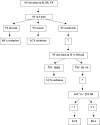Evolving myocardial infarction with ST elevation: ups and downs of ST in different leads identifies the culprit artery and location of the occlusion
- PMID: 15084217
- PMCID: PMC6931954
- DOI: 10.1111/j.1542-474X.2004.92538.x
Evolving myocardial infarction with ST elevation: ups and downs of ST in different leads identifies the culprit artery and location of the occlusion
Figures











References
-
- Myers GB, Klein HA, Stofer BE. Correlation of electrocardiographic findings in anteroseptal infarction. Am Heart J 1948;36: 535–575. - PubMed
-
- Startt Selvester RH, Wagner GS, Ideker RE. Myocardial infarction In McFarlane PW, Veitch Lawrie TD. (eds.): Comprehensive Electrocardiology. New York , Pergamon Press, 1989.
-
- Chou T. Electrocardiography in Clinical Practice. New York , Grune&Stratton, 1979.
-
- Wagner G. Marriott's Practical Electrocardiography. Philadelphia , Lippincott Williams and Wilkins, 2001.
-
- Sclarowsky S. Electrocardiography of Acute Myocardial Ischaemia. London , Martin Dunitz , 1999.
Publication types
MeSH terms
LinkOut - more resources
Full Text Sources
Medical

